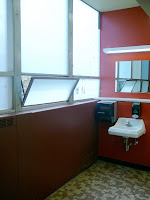Wednesday, April 7, 2010
Monday, April 5, 2010
METHOD CARDs
IDEO created method cards to assist designers throughout their design process. For my PD199 class we are to design products for the bathrooms addressing issues of behavior I have chosen five approaches for each of the four categories of research approach.
MY DESIGN OBJECTIVE: create incentive for restroom users to wash their hands through the use of a enjoyable experience.
Learn
+Affinity Diagrams: Cluster design elements according to intuitive relationships such as similarity, dependence, proximity, etc. This method is a useful way to identify connections between issues and reveal innovation opportunities.
+Activity Analysis: List or represent in detail all tasks, actions, objects, performers, and interactions involved in a process. This is a useful way to identify and prioritize which stakeholders to interview as well as which issues to address.
+Secondary Research: Review published articles, papers, and other pertinent documents to develop an informed point of view on the design issues. This is a useful way to ground observations and to develop a point of view on the state of the art.
+Cognitive Task Analysis: List and summarize all of a user’s sensory inputs, decision points and actions. This is good for understanding users’ perceptual, attentional, and informational needs and to identify bottlenecks where errors may occur.
+Long-Range Forecasts: Write up prose scenarios that describe how social and/or technological trends might influence people's behavior and the use of a product, service, or environment.
Look
Rapid Ethnography: Spend as much time as you can with people relevant to the design topic. Establish their trust in order to visit and/or participate in their natural habitat and witness specific activities. This is a good way to achieve a deep firsthand understanding of habits, rituals, natural language, and meanings around relevant activities and artifacts.
+Fly on the Wall: Observe and record behavior within its context, without interfering with people’s activities. It is useful to see what people actually do within real contexts and time frames, rather than accept what they say they did after the fact.
+Behavioral Mapping: Track the positions and movements of people within a space over time. Recoding the pathways and traffic patterns of occupants of a space helps to define zones of different spatial behaviors.
+Still-Photo Survey: Follow a planned shooting script and capture pictures of specific objects, activities, etc. The Team can use this visual evidence to uncover patterns of behavior and perceptions related to a particular product or context, as well as structure and inspire design ideas.
+Personal Inventory: Document the things that people identify as important to them as a way of cataloging evidence of their lifestyles. This method is useful for revealing people’s activities, perceptions, and values as well as patterns among them.
Ask
+Five Whys?: Ask “Why?” questions in response to five consecutive answers. This exercise forces people to examine and express the underlying reasons for their behavior and attitudes.
+Cognitive Maps: Ask participants to map an existing or virtual space and show how they navigate it. This is a useful way to discover the significant elements, pathways, and other spatial behaviors associated with a real or virtual environment.
+Card Sort: On separate cards, name possible features, functions, or design attributes. Ask people to organize the cards spatially, in ways that make sense to them. This helps to expose people's mental models of a device or system. Their organization reveals expectations and priorities about the intended functions.
+Surveys and Questionnaires: Ask a series of targeted questions in order to ascertain particular characteristics and perceptions of users. This is a quick way to elicit answers from a large number of people.
+Conceptual Landscape: Diagram, sketch, or map the aspects of abstract social and behavioral constructs or phenomena. This is a helpful way to understand people’s mental models of the issues related to the design problem.
Try
+Experience Prototype: Quickly prototype a concept using available materials and use it in order to learn from simulation of the experience using the product. This is useful for revealing unanticipated issues or needs, as well as evaluating ideas.
+Be Your Customer: Ask the client to describe, outline, or enact their typical customer’s experience. This is a helpful way to reveal the client’s perceptions of their customers and provide an informative contrast to actual customer experiences.
+Paper Prototyping: Rapidly sketch, layout, and evaluate interaction design concepts for basic usability. This is a good way to quickly organize, articulate, and visualize interaction design concepts.
+Quick-and-Dirty Prototyping: Using any materials available, quickly assemble possible forms or interactions for evaluation. This is a good way to communicate a concept to the team and evaluate how to refine the design.
+Try It Yourself: Use the product or prototype you are designing. Trying the product being designed prompts the team to appreciate the experience the actual users might have.


















